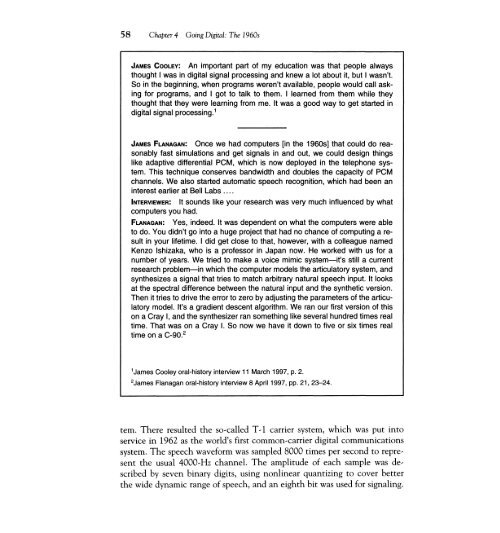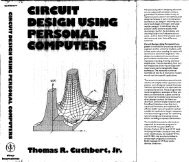Going Digital: The 1960s - IEEE Global History Network
Going Digital: The 1960s - IEEE Global History Network
Going Digital: The 1960s - IEEE Global History Network
Create successful ePaper yourself
Turn your PDF publications into a flip-book with our unique Google optimized e-Paper software.
58 Chapter 4 <strong>Going</strong> <strong>Digital</strong>: <strong>The</strong> <strong>1960s</strong><br />
JAMES COOLEY: An important part of my education was that people always<br />
thought I was in digital signal processing and knew a lot about it, but I wasn't.<br />
So in the beginning, when programs weren't available, people would call asking<br />
for programs, and I got to talk to them. I learned from them while they<br />
thought that they were learning from me. It was a good way to get started in<br />
digital signal processing. 1<br />
JAMES FLANAGAN: Once we had computers [in the <strong>1960s</strong>] that could do reasonably<br />
fast simulations and get signals in and out, we could design things<br />
like adaptive differential PCM, which is now deployed in the telephone system.<br />
This technique conserves bandwidth and doubles the capacity of PCM<br />
channels. We also started automatic speech recognition, which had been an<br />
interest earlier at Bell Labs ....<br />
INTERVIEWER: It sounds like your research was very much influenced by what<br />
computers you had.<br />
FLANAGAN: Yes, indeed. It was dependent on what the computers were able<br />
to do. You didn't go into a huge project that had no chance of computing a result<br />
in your lifetime. I did get close to that, however, with a colleague named<br />
Kenzo Ishizaka, who is a professor in Japan now. He worked with us for a<br />
number of years. We tried to make a voice mimic system-it's still a current<br />
research problem-in which the computer models the articulatory system, and<br />
synthesizes a signal that tries to match arbitrary natural speech input. It looks<br />
at the spectral difference between the natural input and the synthetic version.<br />
<strong>The</strong>n it tries to drive the error to zero by adjusting the parameters of the articulatory<br />
model. It's a gradient descent algorithm. We ran our first version of this<br />
on a Cray I, and the synthesizer ran something like several hundred times real<br />
time. That was on a Cray I. So now we have it down to five or six times real<br />
time on a C-90. 2<br />
1James Cooley oral-history interview 11 March 1997, p. 2.<br />
2James Flanagan oral-history interview 8 April 1997, pp. 21, 23-24.<br />
tern. <strong>The</strong>re resulted the so..called T .. 1 carrier system, which was put into<br />
service in 1962 as the world's first common..carrier digital communications<br />
system. <strong>The</strong> speech waveform was sampled 8000 times per second to repre..<br />
sent the usual 4000..Hz channel. <strong>The</strong> amplitude of each sample was de..<br />
scribed by seven binary digits, using nonlinear quantizing to cover better<br />
the wide dynamic range of speech, and an eighth bit was used for signaling.
















